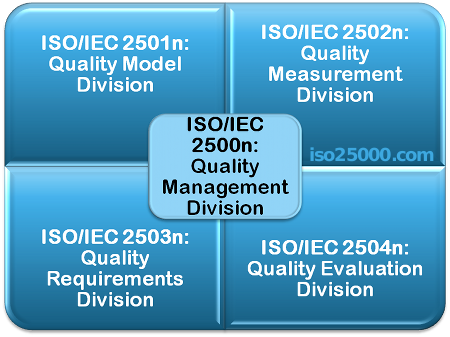ISO 25000
The ISO/IEC 25000 series of standards
The series of standards ISO/IEC 25000, also known as SQuaRE (System and Software Quality Requirements and Evaluation), has the goal of creating a framework for the evaluation of software product quality.
ISO/IEC 25000 is the result of the evolution of several other standards; specifically from ISO/IEC 9126, which defines a quality model for software product evaluation, and ISO/IEC 14598, which defines the process for software product evaluation. The series of standards ISO/IEC 25000 consists of five divisions.

ISO/IEC 2500n – Quality Management Division
The standards that form this division define all common models, terms and definitions referred further by all other standards from SQuaRE series. Currently, this division consists of the following standards:
- ISO/IEC 25000 - Guide to SQuaRE: Provides the SQuaRE architecture model, terminology, documents overview, intended users and associated parts of the series as well as reference models.
- ISO/IEC 25001 - Planning and Management: Provides requirements and guidance for a supporting function which is responsible for the management of software product requirements specification and evaluation.
ISO/IEC 25010
The quality model is the cornerstone of a product quality evaluation system. The quality model determines which quality characteristics will be taken into account when evaluating the properties of a software product.
The quality of a system is the degree to which the system satisfies the stated and implied needs of its various stakeholders, and thus provides value. Those stakeholders' needs (functionality, performance, security, maintainability, etc.) are precisely what is represented in the quality model, which categorizes the product quality into characteristics and sub-characteristics.
The product quality model defined in ISO/IEC 25010 comprises the nine quality characteristics shown in the following figure:

Functional Suitability
This characteristic represents the degree to which a product or system provides functions that meet stated and implied needs when used under specified conditions. This characteristic is composed of the following sub-characteristics:
- Functional completeness - Degree to which the set of functions covers all the specified tasks and intended users' objectives.
- Functional correctness - Degree to which a product or system provides accurate results when used by intended users.
- Functional appropriateness - Degree to which the functions facilitate the accomplishment of specified tasks and objectives.
SO/IEC 25059
The increasing incorporation of Artificial Intelligence (AI) systems in organisations has led to the extension of the characteristics of the quality model of the ISO/IEC 25010 standard to include those additional aspects that these systems present.
The changes in ISO/IEC 25059 with regard to product quality are the following:
Functional Suitability incorporates the subcharacteristic:
- Functional Adaptability. Degree to which an AI system can accurately acquire information from data, or the result of previous actions, and use that information in future predictions.
For Functional Correctness, ISO/IEC 25059 warns that machine learning methods often do not provide functional correctness in all observed circumstances, so it is necessary to measure correctness and incorrectness carefully.
Usability incorporates two subcharacteristics:
- User Controllability. Degree to which a user can adequately intervene in the operation of an AI system in an adequate manner.
- Transparency. Degree to which adequate information about the AI system is communicated to stakeholders.
Reliability incorporates the subcharacteristic:
- Robustness. Degree to which an AI system can maintain its level of performance under all circumstances.
Security incorporates the subcharacteristic:
- Intervenability. Degree to which an operator can intervene in the operation of an AI system in a timely manner to avoid damage or danger.
ISO/IEC 25012
The Data Quality model represents the grounds where the system for assessing the quality of data products is built on. In a Data Quality model, the main Data Quality characteristics that must be taken into account when assessing the properties of the intended data product are established.
The Quality of a Data Product may be understood as the degree to which data satisfy the requirements defined by the product-owner organization. Specifically, those requirements are the ones that are reflected in the Data Quality model through its characteristics (Accuracy, Completeness, Consistency, Credibility, Currentness, Accessibility...).
The Data Quality model defined in the standard ISO/IEC 25012 is composed of 15 characteristics, shown in the picture bellow:
ISO/IEC 5259
ISO/IEC 5259 describes a data quality model for data analytics and artificial intelligence based on machine learning (ML).
This standard is based on the ISO/IEC 25012 model, and like ISO/IEC 25012 differentiates between two types of characteristics: inherent and system-dependent, to which it adds a new category of additional characteristics.
ISO/IEC 25040
ISO/IEC 25040 provides a process description for evaluating quality of software product and states the requirements for the application of this process. The evaluation process is composed of five activities.






